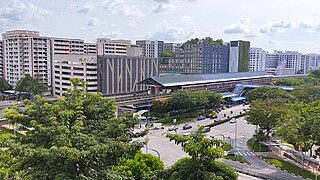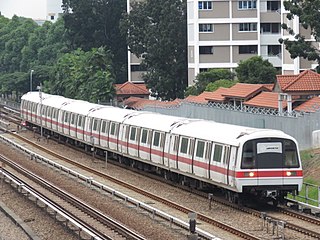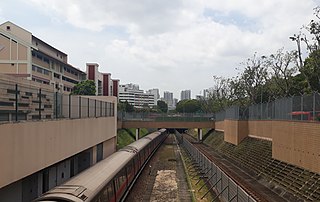
The Mass Rapid Transit system, locally known by the initialism MRT, is a rapid transit system in Singapore and the island country's principal mode of railway transportation. The system commenced operations in November 1987 after two decades of planning with an initial 6 km (3.7 mi) stretch consisting of five stations. The network has since grown to span the length and breadth of the country's main island – with the exception of the forested core and the rural northwestern region – in accordance with Singapore's aim of developing a comprehensive rail network as the backbone of the country's public transportation system, averaging a daily ridership of 3.45 million in 2023.

The North–South Line (NSL) is a high-capacity Mass Rapid Transit (MRT) line in Singapore, operated by SMRT Corporation. Coloured red on the Singapore rail map, the line is 45 kilometres (28 mi) long and serves 27 stations, 11 of which, between the Bishan and Marina South Pier stations, are underground. It runs from Jurong East station, located in Western Singapore, to Marina South Pier station in the Central Area, via Woodlands station in northern Singapore. The line operates for almost 20 hours a day, with headways of up to 1 to 2 minutes during peak hours and 5 to 8 minutes during off-peak hours. All the trains on the North–South Line run with a six-car formation.

The East–West Line (EWL) is a high-capacity Mass Rapid Transit (MRT) line operated by SMRT in Singapore, running from Pasir Ris station in the east to Tuas Link station in the west, with an additional branch between Changi Airport and Tanah Merah stations. It is the second Mass Rapid Transit line to be built in Singapore. Coloured green on the rail map, the line serves 35 stations, 8 of which are underground. At 57.2 kilometres (35.5 mi), the line is the longest on the MRT network.

The Circle Line (CCL) is a medium-capacity Mass Rapid Transit (MRT) line in Singapore. It runs in a loop from Dhoby Ghaut station in the city-centre to HarbourFront station in the south via Bishan station in the centre of the country. It also has a branch to Marina Bay station from Promenade station, which will be extended to HarbourFront station from 2026 to form a complete loop. Coloured orange on the rail map, the fully-underground line is approximately 35.5 kilometres (22.1 mi) long with 30 stations. Travelling from one end of the line to the other takes about an hour.

Paya Lebar MRT station is a Mass Rapid Transit (MRT) interchange station on the East West line (EWL) and Circle line (CCL) in Geylang, Singapore. Despite the name, this station is not located in Paya Lebar but rather along Paya Lebar Road, near the junction with Sims Avenue. It is located among the developments of the Paya Lebar Central commercial hub and near the Geylang Serai district.

Bishan MRT station is a Mass Rapid Transit (MRT) interchange station on the North–South (NSL) and Circle (CCL) lines in Bishan, Singapore. The station is located along Bishan Road within the town centre; it is integrated with Junction 8 shopping centre and is close to Bishan Bus Interchange. Nearby schools include Raffles Institution, Catholic High School, and Kuo Chuan Presbyterian Primary and Secondary Schools.

Pasir Ris MRT station is an elevated Mass Rapid Transit (MRT) station on the East West line (EWL) in Pasir Ris, Singapore. Situated along Pasir Ris Central adjacent to Pasir Ris Bus Interchange, Pasir Ris Mall and the White Sands Shopping Mall, it is the eastern terminus of the EWL. The station exterior has the characteristic dome-shaped segmented roof also seen on other elevated EWL stations.

Ang Mo Kio MRT station is an above-ground Mass Rapid Transit (MRT) station on the North South Line in Ang Mo Kio, Singapore.

Dover MRT station is an elevated Mass Rapid Transit (MRT) station on the East West line (EWL) in Singapore. Located along Commonwealth Avenue West, the station is directly linked to Singapore Polytechnic and serves various residential developments in the area. The station is operated by SMRT Trains.

Clementi MRT station is an elevated Mass Rapid Transit (MRT) station on the East–West Line (EWL). Located in Clementi, Singapore, the station is located along Commonwealth Avenue West and serves landmarks such as the Clementi Mall, the Clementi Bus Interchange, and Clementi Fire Station.

Braddell MRT station is an underground Mass Rapid Transit (MRT) station located on the North South line (NSL) in Toa Payoh, Singapore. Unlike the other stations on the NSL, the station has side platforms due to engineering constraints. Located underneath the traffic junction of Lorong 1 Toa Payoh and Lorong 2 Toa Payoh, Braddell station primarily serves the estates in the northern part of Toa Payoh New Town.

Kranji MRT station is an elevated Mass Rapid Transit (MRT) station on the North–South Line (NSL). Situated in Sungei Kadut, Singapore, along Woodlands Road, it serves the Singapore Turf Club and the Woodlands Wafer Fabrication Park. The station is operated by SMRT Trains.

Admiralty MRT station is an elevated Mass Rapid Transit (MRT) station on the North South line (NSL) in Woodlands, Singapore. Located along Woodlands Avenue 7 near the junctions of Woodlands Avenue 6 and Woodlands Drive 71, the station primarily serves the residential precincts in the eastern part of Woodlands New Town. This station took its name from a former Royal Navy base located on the northern coast of Singapore.

Yio Chu Kang MRT station is an above-ground Mass Rapid Transit (MRT) station on the North South line in Ang Mo Kio, Singapore, near the junction of Ang Mo Kio Avenue 6 and Ang Mo Kio Avenue 8.

Bedok MRT station is an elevated Mass Rapid Transit (MRT) station on the East–West Line (EWL) in Bedok, Singapore. Operated by SMRT Trains, the station serves the Bedok area and its landmarks such as Bedok Bus Interchange and Bedok Mall. It is reportedly one of the busiest stations on the eastern portion of the EWL.

Aljunied MRT station is an above-ground Mass Rapid Transit (MRT) station on the East West line (EWL) in Geylang, Singapore. Named after Aljunied Road, this station primarily serves Aljunied, one of the subzones that make up Geylang planning area.

The Siemens C651 was the second generation electric multiple unit rolling stock that operated on the North–South and East–West lines of Singapore's Mass Rapid Transit (MRT) system, manufactured by Siemens Mobility (SIE) and SGP Verkehrstechnik in Vienna, Austria under Contract 651. A total of 114 cars consisting of 19 trainsets were purchased in 1992 and were in service from 1995 to 2024.

Bishan Depot or is a depot located on the Mass Rapid Transit in Bishan, Singapore. It was completed in 1986 by American architect Vikas M. Gore and the 12,000 square metres maintenance area at cost of S$300 million.

The Joo Koon rail accident, sometimes referred to as the Joo Koon train collision, was a crash which happened on 15 November 2017, when a C151A train travelling at 16 kilometres per hour (9.9 mph) rear-ended a stationary C151A train at Joo Koon station on the East–West MRT line, resulting in 38 injuries. The stationary train was in the process of being detrained due to a train fault. Both trains were operating under the recently installed Thales SelTrac CBTC signalling system at the time of incident, and the Minister of Transport Khaw Boon Wan expressed that he was "disturbed" by an initial finding that "critical safety software" was inadvertently removed from the stationary train, possibly due to a malfunctioning signalling circuit, which led to the crash. This incident is the second train collision in Singapore MRT's history, after the Clementi rail accident.

The Bishan MRT tunnel flooding was a major incident on the North South MRT line (NSL) of the Singapore MRT which occurred at 5.33 pm on 7 October 2017. The flooding of the tunnels between the Bishan and Braddell MRT stations was caused by heavy rain and a faulty maintenance pump. The flooding completely blocked the tunnel, and bus services had to be deployed while the Singapore Civil Defence Force and maintenance staff removed the water from the tunnel. The incident caused more than S$2 million in damages and lost revenue for the operator SMRT and led to the firing of eight maintenance employees.
































